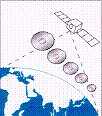 |
INTERNATIONAL SYMPOSIUM ON INFORMATION TECHNOLOGY IN OCEANOGRAPHY (ITO-98) GOA, INDIA 12-16 OCTOBER 1998 |
 |
INTERNATIONAL SYMPOSIUM ON INFORMATION TECHNOLOGY IN OCEANOGRAPHY (ITO-98) GOA, INDIA 12-16 OCTOBER 1998 |
ECOLOGICAL ADAPTIVE MODELS FOR FORECASTING OF THE STATE AND MIGRATION OF THE MARINE BIOTA
A.S. VASILIEV |
The major physical fields of the Arabian see of the Indian Ocean are reconstructed with a mathematical model using the satellite data on surface temperature and atmospheric pressure. Statistics of the subsequent scenarios created for the medium state allow their use for forecasting thermodynamical structures and biota with the help of adaptive leaning models.
One of the main problems in the marine ecological modelling is reconstruction of the major physical fields (currents, temperature, salinity, density) in the mode of continues processes monitoring. The mathematical models for medium state diagnosis by continues monitoring should meet the following requirements: a fast realisation by small computers; a necessity to account for the region orography and topography, water exchange in through the straits and "liquid boundaries"; a possibility of using the satellite data of the ocean surface remote sensing and standard hydrometeorological monitoring of the atmospheric pressure.
The paper considers a mathematical model allowing solution of this problem. To this end, the principles of self-similarity of the second order are used. These principles permit splitting variables according to self-similarity functions. Thus, the problem of simulation of the spatial distribution of the physical parameters is reduced to computation of the self-similarity functions.
When the self-similarity functions are determined, the spatial distribution of currents, salinity and density is derived from the explicit formulas. A similar approach can by also employed for computations of dissolved gases and biogenic elements.
Based on modelling of probabilistic processes in the classes of complicated marine dynamic systems and using a mixed instrumental and theoretical monitoring of environment, an adaptive leaning forecasting technology has been developed for computer studies and forecasting of the sea and oceanic system evolution. The computer-fed model is used by biologists for adaptation, learning and forecasting.
Analysed are the results of an application of the technology to forecasting of the state and migration of the marine biota.
[ITO - 98] [Welcome] [1998 - Internetional Year of the Oceans] [Objectives of ITO-98] [Plenary Lectures] [Technical Sessions] [Commercial/Corporate Presentation] [Exhibition/Demonstration] [Ocean IT CDROM] [Awards/Financial Assistance] [Fees / Charges] [Souvenir] [Post Symposium Event] [International Scientific Programme Committee] [Organizing Committee] [Schedule] [Scientific Programme Summary] [The Host] [Travelling / Accomodation] [Registration Forms] [Abstracts]
 |
|
 |

Copyright© National Institute Of Oceanography,
Goa,India,1998
updated on 7th July'98